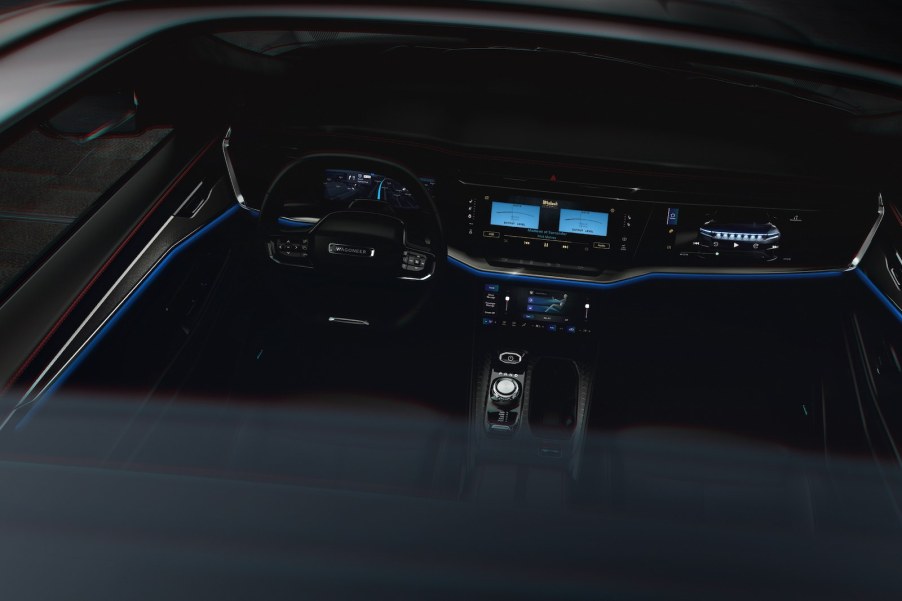
Here’s Why Jeep’s Decision to Trade Buttons for More Screens Is Already Outdated
Here’s the breaking news: Jeep just revealed photos of its first production EV, the Wagoneer S. This SUV will have up to 600 horsepower and a refined, luxurious interior. The upcoming Jeep Wagoneer S EV has four separate touch screens and appears to have no buttons on its dashboard.
Here’s the hot take: While Jeep was still relying on sales of its full-frame SUVs with solid front axles, other automakers were experimenting with buttonless interiors. But they weren’t popular with drivers for good reasons. And they are already out of fashion.
Building exclusively touchscreen controls is one of the many ways automakers are designing EVs to look like EVs are supposed to. The result is more a novelty than a workable daily driver. Early adopters deserve more conscientious engineering.

By the mid 20-teens, many automakers were deleting buttons from their cars’ dashboards. Gone were radio preset buttons, gone were physical HVAC controls, even gone was the volume knob.
This was especially common in more budget-friendly sedans and crossovers because–let’s be honest–saving a few pennies a car adds up. But it was also seen as a forward-thinking solution which gave even cheap cars a Tesla-style “clean” interior design. There was only one problem: buyers hated it.
Let’s say you are driving down the road and an especially loud song or advertisement comes on the radio. If you have a physical volume knob, you can adjust the volume without taking your eyes off the road. If volume is buried in a touch screen menu, you have to wait for a stoplight or look away from traffic. Not ideal.

The same is absolutely true for things such as HVAC controls. And in the case of Tesla, even the turn signals. Yes, Tesla deleted the turn signal stalks.
A study by the AAA found infotainment touch screens can distract a driver for up to 40 seconds. At 50 mph, that’s half a mile of blind driving.
Jay Caspian Kang wrote an Op-Ed in the NYTs with a title I love: “Touch Screens in Cars Solve a Problem We Didn’t Have.”
“I can think of no better way of describing the frustration of the modern consumer than buying a car with a feature that makes you less safe, doesn’t improve your driving experience in any meaningful way, saves the manufacturer money and gets sold to you as some necessary advance in connectivity.”
Jay Caspian Kang, New York Times
Even the designer of the original iMac, iPod, iPhone, and iPad–Sir Jony Ive–went on record saying that in a car a touchscreen can’t match the tactile experience of a button or other physical controls. “We do remain physical beings. I think, potentially, the pendulum may swing a little to have interfaces and products that will take more time and are more engaged physically.”
But this isn’t a journalist-only complaint. Drivers are also not all about the touchscreen-only trend. When J.D. Power interviewed car owners last year it found “infotainment remains a significant issue for new vehicles.” Enough folks are speaking up that automakers have been forced to listen.
In 2020, Honda redesigned several models and brought back physical controls it had deleted on previous generations. The most recent generation of the Corolla brought physical buttons and dials its predecessor had lacked back to the dashboard.

Volkswagen has abandoned its experiment with steering-wheel mounted touch controls. And its Porsche division is going back to physical buttons for the 2024 Cayenne. The CEO of Alfa Romeo famously told Caradisiac, “I don’t sell an iPad with a car around it, I sell an Alfa Romeo.” He then pledged future models would have “as few screens as possible.”
It’s interesting to note that many of the highest-end automakers, such as Bugatti, take great pride in the design and execution of their physical controls. The current Bugatti is one example that’s proudly never had a screen.
And this brings us back to the Wagoneer S. Jeep had a real opportunity here to offer a cutting-edge powertrain with a distinctly different experience. If drivers want a “clean” and “futuristic” electric SUV, they can have their pick of Range Rovers or Teslas. But the Jeep 4xe PHEV lineup is selling well for the opposite reason. The Jeep EV could have offered futuristic capability where necessary (complete with a robust 600 horsepower AWD system) and old-school tactile experiences wherever possible. But instead, Jeep went with a design that will already be dated when the Wagoneer S hits dealerships later this year.
Next, see the pros and cons of the new Wagoneer’s design, or learn the truth about the rise of touchscreens in cars in the video below:





